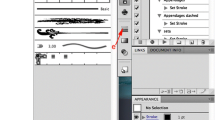Abstract
This paper focuses on the problem of designing and generating illustrations that portray a given scene with a single non-intersecting line. In this approach, users partition an image into regions, assigning a type or style to each of them. Next, a grid is generated over the drawing space, based on the parameters specified for each region. The illustration is then obtained in the form of a path that covers most areas of the grid. Contrary to previous works, our approach allows users to control the overall flow of the line throughout any given region, by providing the means to define tensor fields per region which directly influence the line orientation. We also extend this work for generating continuous-line paintings, a similar style consisting of a single line that varies in color and thickness while covering the entire drawing space. This is achieved by transforming drawings obtained with the above-mentioned approach through a Voronoi-based strategy.












Similar content being viewed by others
References
Alliez, P., Cohen-Steiner, D., Devillers, O., Lévy, B., Desbrun, M.: Anisotropic polygonal remeshing. ACM Trans. Graph. 22(3), 485–493 (2003)
Applegate, D.L., Bixby, R.E., Chvatal, V., Cook, W.J.: The Traveling Salesman Problem: A Computational Study. Princeton Series in Applied Mathematics. Princeton University Press, Princeton (2007)
Applegate, D.L., Bixby, R.E., Chvatal, V., Cook, W.J.: Concorde TSP solver (2011). http://www.tsp.gatech.edu/concorde/index.html
Bosch, R., Herman, A.: Continuous line drawings via the traveling salesman problem. Oper. Res. Lett. 32(4), 302–303 (2004)
CGAL: Cgal, Computational Geometry Algorithms Library (2012). http://www.cgal.org
Chi, M.T., Lee, T.Y., Qu, Y., Wong, T.T.: Self-animating images: illusory motion using repeated asymmetric patterns. ACM Trans. Graph. 27(3), 62:1–62:8 (2008)
Cohen-Or, D., Sorkine, O., Gal, R., Leyvand, T., Xu, Y.Q.: Color harmonization. ACM Trans. Graph. 25(3), 624–630 (2006)
Cox, I., Miller, M., Bloom, J., Fridrich, J., Kalker, T.: Digital Watermarking and Steganography, 2nd edn. Morgan Kaufmann, San Francisco (2008)
Douglas, D.H., Peucker, T.K.: Algorithms for the reduction of the number of points required to represent a digitized line or its caricature. Cartographica 10(2), 112–122 (1973)
Garey, M.R., Johnson, D.S.: Computers and Intractability; A Guide to the Theory of NP-Completeness. W.H. Freeman, New York (1990)
Granger, G.: EOL B-spline Library (2009). http://www.eol.ucar.edu/homes/granger/bspline/doc/
Huang, L., Wan, G., Liu, C.: An improved parallel thinning algorithm. In: ICDAR ’03: Proceedings of the 7th International Conference on Document Analysis and Recognition, p. 780. IEEE Computer Society, Washington (2003)
Jobard, B., Lefer, W.: Creating evenly-spaced streamlines of arbitrary density. In: Proceedings of the 8th Eurographics Workshop on Visualization in Scientific Computing, pp. 45–55 (1997)
Kang, H., Lee, S., Chui, C.K.: Flow-based image abstraction. IEEE Trans. Vis. Comput. Graph. 15(1), 62–76 (2009)
Kaplan, C.S., Bosch, R.: TSP art. In: Proceedings of Bridges 2005, Mathematical Connections in Art, Music and Science, pp. 301–308 (2005)
Li, Y., Sun, J., Tang, C.K., Shum, H.Y.: Lazy snapping. ACM Trans. Graph. 23(3), 303–308 (2004)
Maharik, R., Bessmeltsev, M., Sheffer, A., Shamir, A., Carr, N.: Digital micrography. ACM Trans. Graph. 30(4), 100:1–100:12 (2011)
Morales, J.E.: Virtual Mo (2005). http://www.virtualmo.com/
O’Donovan, P., Hertzmann, A.: Anipaint: interactive painterly animation from video. IEEE Trans. Vis. Comput. Graph. 18(3), 475–487 (2012)
Okamoto, Y., Uehara, R.: How to make a picturesque maze. In: CCCG, pp. 137–140 (2009)
Orzan, A., Bousseau, A., Winnemöller, H., Barla, P., Thollot, J., Salesin, D.: Diffusion curves: a vector representation for smooth-shaded images. ACM Trans. Graph. 27(3), 92:1–92:8 (2008)
Pedersen, H., Singh, K.: Organic labyrinths and mazes. In: NPAR ’06: Proceedings of the 4th International Symposium on Non-Photorealistic Animation and Rendering, pp. 79–86. ACM, New York (2006)
Pullen, W.D.: Think labyrinth (2008). http://www.astrolog.org/labyrnth.htm
Ramer, U.: An iterative procedure for the polygonal approximation of plane curves. Comput. Graph. Image Process. 1(3), 244–256 (1972)
Rother, C., Kolmogorov, V., Blake, A.: “GrabCut”: interactive foreground extraction using iterated graph cuts. ACM Trans. Graph. 23(3), 309–314 (2004)
Slater, G.: Geoff Slater—the kilted, single line artist (2001). http://www.geoffslater.com/
Wan, L., Liu, X., Wong, T.T., Leung, C.S.: Evolving mazes from images. IEEE Trans. Vis. Comput. Graph. 16(2), 287–297 (2010)
Wong, F.J., Takahashi, S.: Flow-based automatic generation of hybrid picture mazes. Comput. Graph. Forum 28(7), 1975–1984 (2009)
Wong, F.J., Takahashi, S.: A graph-based approach to continuous line illustrations with variable levels of detail. Comput. Graph. Forum 30(7), 1931–1939 (2011)
Xu, J., Kaplan, C.S.: Image-guided maze construction. ACM Trans. Graph. 26(3), 29 (2007)
Zhang, E., Hays, J., Turk, G.: Interactive tensor field design and visualization on surfaces. IEEE Trans. Vis. Comput. Graph. 13(1), 94–107 (2007)
Acknowledgements
We thank all the participants in our preliminary user study for helping us in this algorithm formulation. This research has been partially supported by Japan Society for the Promotion of Science under Grants-in-Aid for Scientific Research (B) No. 21300033, and Challenging Exploratory Research No. 23650042.
Author information
Authors and Affiliations
Corresponding author
Rights and permissions
About this article
Cite this article
Wong, F.J., Takahashi, S. Abstracting images into continuous-line artistic styles. Vis Comput 29, 729–738 (2013). https://doi.org/10.1007/s00371-013-0809-1
Published:
Issue Date:
DOI: https://doi.org/10.1007/s00371-013-0809-1




